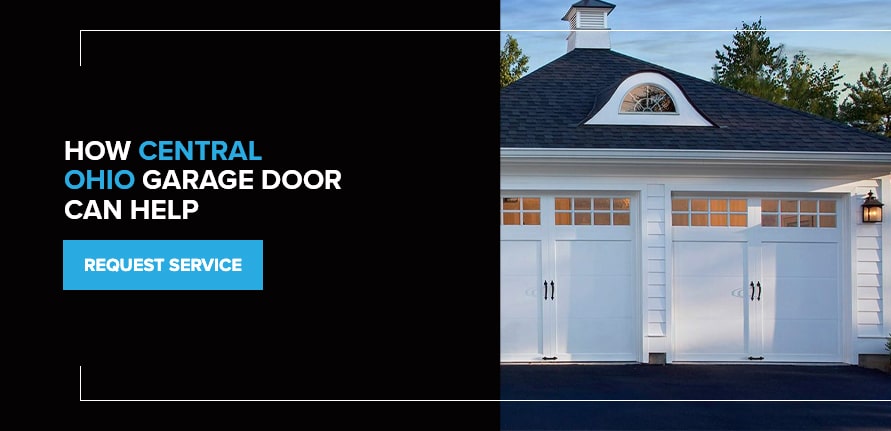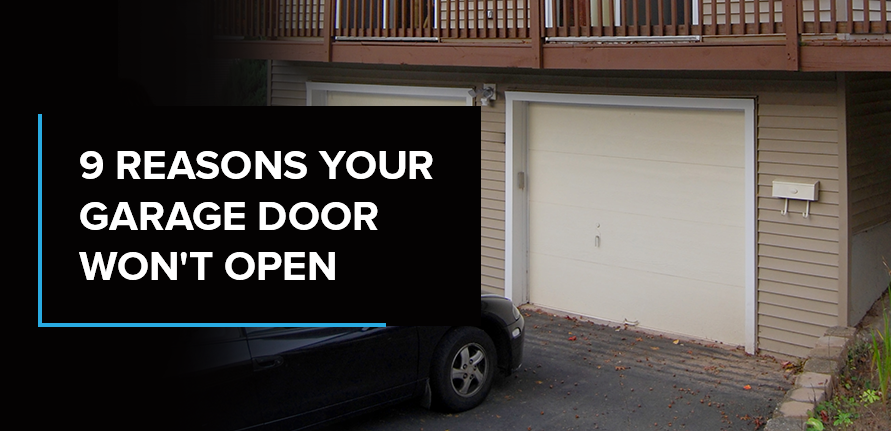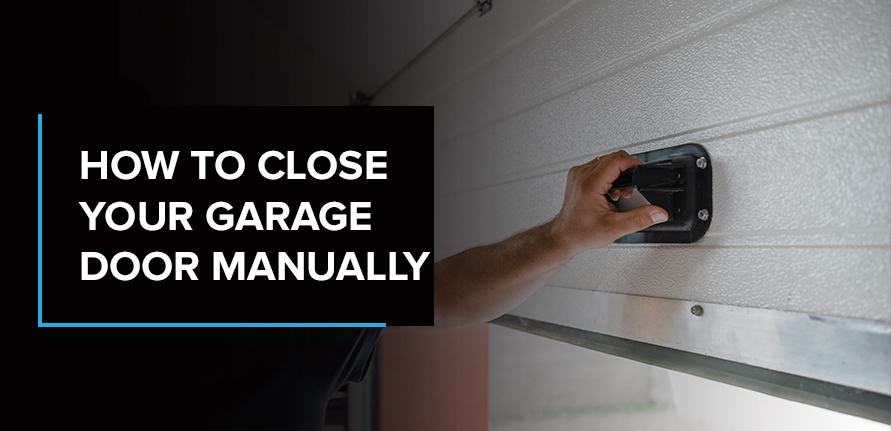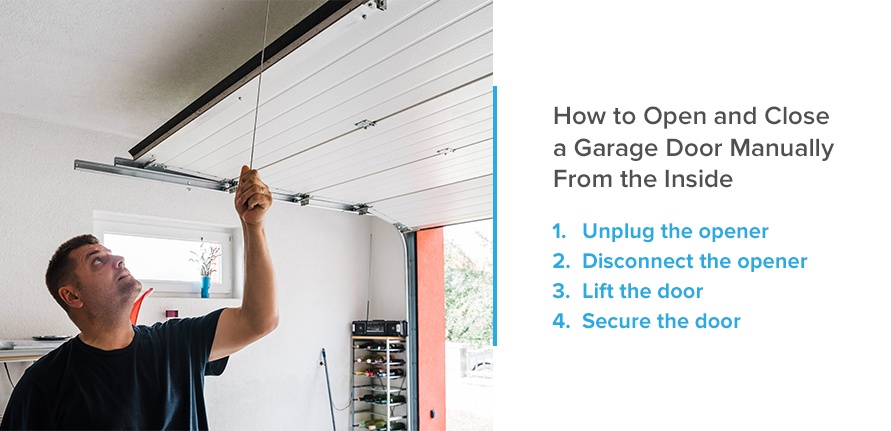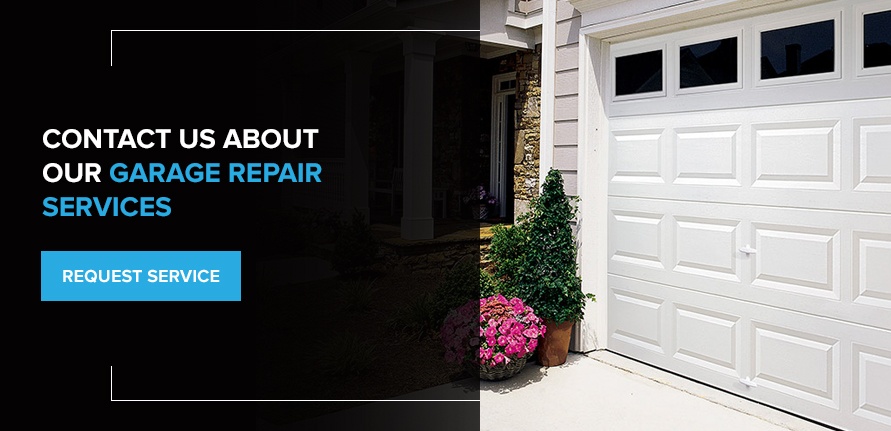Garage Door Buying Guide
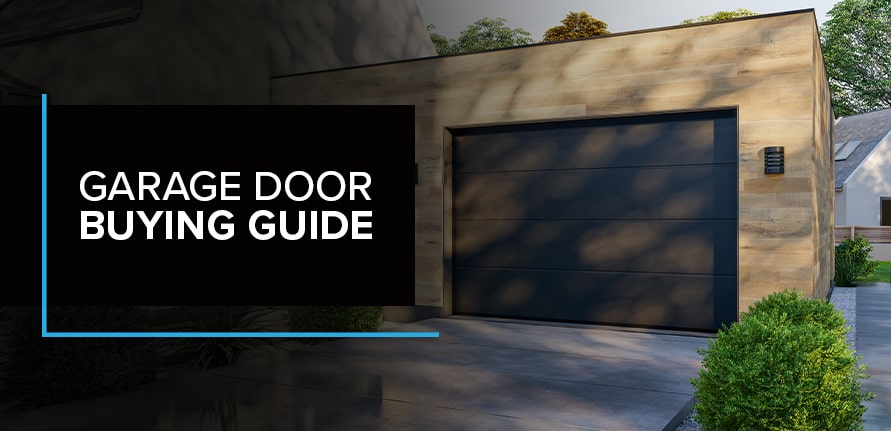
A new garage door can significantly transform your home’s appearance. The right garage door keeps your home secure, helps with insulation, enhances curb appeal and lasts for years. Upgrading your garage door lets you enjoy the benefits of a fresh, modern door and keeps you from constantly performing repairs.
If you’re overwhelmed by getting a new garage door, check out our garage doors guide. We’ve got all the information to help you learnhow to choose a garage door.
3 Reasons to Replace Your Garage Door
Buying a garage door is a significant investment. You may not be ready to upgrade your existing door if it’s only a few years old, but if you want to improve your home, a new garage door may be a good place to start. If you’re on the fence, here are some reasons to consider replacing your garage door:
1. Improve Efficiency
New, multilayer garage doors are incredibly energy-efficient, insulating your garage and preventing the heat and cold from traveling through the door. Insulation dramatically reduces your energy bill over time — the less air that escapes through your garage door, the easier it is for your HVAC system to keep your home at a consistent temperature. With a high-quality, energy-efficient garage door, you’ll save money and enjoy a more comfortable home.
2. Increase Curb Appeal
An updated garage door will bring new life to your home by elevating its exterior. A garage door replacement can make your whole house look younger and more sophisticated, especially if you use contrasting colors and unique accents. A garage door replacement also has one of the best returns on investment (ROIs) at 93.3%. You’ll enhance your home’s appearance and enjoy a boost in home value with a garage door update.
3. Fix Wear and Tear
If your garage is approaching the end of its life or has experienced lots or wear and tear, a replacement is probably your best option. While investing in a new garage door is more expensive upfront, you’ll save money in the long run. New garage doors don’t need as many repairs as older garages, meaning you’ll save money on maintenance. If you’re spotting the tell-tale signs you need a garage door replacement, you should consider an upgrade.
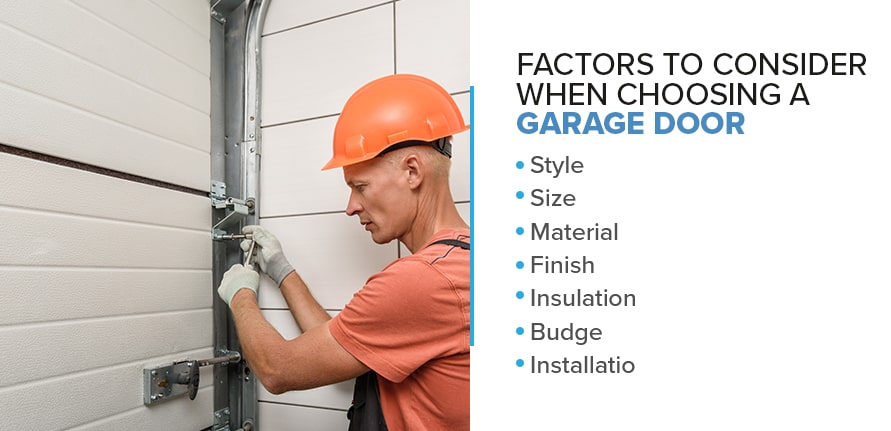
Factors to Consider When Choosing a Garage Door
Several factors will influence your garage door buying decision. The right garage door will meet all of your budget, style and insulation needs without sacrificing comfort. To buy a garage door, you’ll want to determine your preferences and options. Getting a clear idea of what you want will help you narrow your selection. Here are some of the factors you should consider when picking out your new garage door:
Style
Door style will heavily influence the look of your home and garage. Try to choose a style that complements your home’s architecture and existing color. Whether you prefer modern, traditional or carriage house doors, the style you pick will impact your home’s look.
When choosing a garage door style, consider colors, paneling and hardware. Sleek lines or elaborate hardware can give your door a new personality and transform your home into a cohesive piece. You can also think about how the door opens — does it slide up and down or open outwardly?
Size
Your garage door needs to fit your existing garage structure. Garages often fit one or two vehicles — measure your garage door to find the best fit for your space. A standard single-car garage is around 7-8 feet tall and 8-9 feet wide, with double-car garage doors hitting about 16 feet wide. Getting the right size is crucial for a well-fitting, functional garage door.
Material
Garage door material affects the door’s price, durability, look and maintenance. Natural wood doors require much more upkeep than other materials, while steel garage doors are ultra-durable. Aluminum is a great, lightweight door option. Aluminum is also resistant to rust, which may be important if you live in a rainy area. Depending on the material you select, you can also get different paneling and window options, further elevating your garage door’s look.
Finish
Adding a finish to your garage door can transform its look. Steel doors with an Ultra-Grain® finish mimic the luxurious look of natural wood without the upkeep. Bold colors can add a much-needed pop to your garage door without overwhelming your home. Make your door as matte or glossy as you want — your finish options are enormous. A finish is a great way to elevate a garaged door, especially if you want a higher-end look without the cost. A quality finish will protect your garage door and create a sophisticated look.
Insulation
There are multiple garage door insulation options to choose from. Homeowners looking to maximize their energy savings or prevent temperature loss in more extreme climates should select a multilayered, Intellicore® insulated door. Intellicore insulation expands to fill all the gaps between garage door layers, sealing your home against heat and cold loss as the outdoor temperatures change. The better your insulation, the more expensive your door will be. However, quality insulation keeps your door quiet and prevents insect intrusion and temperature changes in your garage.
Budget
Budget is often a deciding factor for homeowners. Not spending enough money can leave you with a less durable and insulative door than you need. The garage door’s cost will increase depending on your finish, layers, material, style, hardware and more. The more insulation you need, the more expensive our door will be. If you’re living somewhere with more extreme temperatures, you’ll want to budget for a door with more layers and insulation to ensure your door holds up and keeps you comfortable.
Installation
Choosing between DIY and professional installation can also affect your garage door choice. Some experienced homeowners feel confident installing lightweight doors on their own. However, most garage doors are heavy, and it’s often safer to let professionals perform the installation for you. While you’ll pay more for professional installation, you’ll keep yourself safe and ensure the installation is done correctly.
How Central Ohio Garage Door Can Help
As a full-service, family-owned and operated business, you can trust Central Ohio Garage Door to provide you with the best garage door services around. Our mission is to deliver high-quality, lasting garage doors to our customers, whatever their needs. Customer service is a top priority for our team — we’ll work with you to find a garage door that fits your budget and exceeds your expectations. If you’re interested in installing a top-of-the-line Clopay® garage door, contact us to get started today.
9 Reasons Your Garage Door Won’t Open
Perhaps you’ve found that your garage door isn’t working with your remote, or you’re having problems with the garage door opener itself. These issues can have a big impact on your daily life, especially if you use your garage for things beyond just parking your car, like storing kids’ toys or working on projects. When your garage door can operate properly again, you have one less thing to worry about.
Below, we cover several reasons why your garage door isn’t working and what you can do to fix it.
1. Dead Transmitter Batteries
Perhaps one of the most common reasons a garage door remote opener isn’t working is dead transmitter batteries. Having dead batteries means you won’t be able to send a signal from your opener to your garage door.
To check what part of the garage door might need replacing, go to the transmitter on the wall and test it for power. If it still opens your garage door after being pressed, you should only need to replace the battery in your remote. If you have more than one remote, check the other remotes, as they may also need replacing.
The Solution
To change the transmitter batteries, slide open the transmitter’s door and remove the batteries from the back. The door may be screwed shut, so be sure to have a screwdriver handy. After removing the batteries, line up the plus and minus signs and place the new batteries inside the device. Test the transmitter afterward to ensure it works. Then, put the door back.
2. Disrupted Signal
If you’ve replaced the batteries and the garage door doesn’t respond, it may be due to a disrupted signal. A disrupted signal occurs when you click the remote out of range or the antenna is broken.
The Solution
Stand no more than 20 feet away from the garage before clicking the remote button. If you’re too far away, the garage may not respond. If you stand close and the door doesn’t respond, try removing objects out of the way, as something could be blocking the signal.
Perhaps the antenna is broken and requires professional repair. If you can’t fix or realign the antenna yourself, call someone to inspect and fix the problem.
3. Misaligned Photo Eyes
A garage door’s photo eyes help detect objects and people that block the door’s path. This is a safety measure that ensures the door doesn’t close on top of someone or something. Inspect the photo eyes if the garage door opens but fails to close normally when the remote is pressed. When the photo-eye is dirty, the beams become blocked or misaligned, causing a mismatched eye that fails to signal the door to close.
The Solution
Though photo eyes are small, they can quickly become dirty. Use a soft cloth and a mild cleaner to wipe off dirt and residue. Try not to leave excess wetness as that could cause dirt and debris to stick to the photo eye.
Using a level, you can check the eyes’ alignment by measuring the height of the photo eyes from the ground. Make sure they point in the same direction and angle, as any misalignment could cause your garage door to malfunction or stay open.
After adjusting the devices, test the garage door once more. If you’re still experiencing issues, call a professional to have the door and photo eyes inspected.
4. Misaligned Track
If the metal track on your garage door is misaligned, it could cause gaps or bends between the rollers and rail, creating more significant issues in the future.
The Solution
Test the door to see if it still moves correctly. You might hear a rubbing or scraping noise when the door slows down and hits the spot where it’s misaligned. In this case, it’s best to call a garage door professional to come and inspect your door, as you don’t want to harm yourself trying to realign the track on your own.
5. Blocked Path
A blocked path is one of the most common reasons your garage door won’t open with a remote. When objects like garbage cans, furniture or toys lie in the way of the sensors or the door itself, the garage door will refuse to close thanks to the door’s photo eyes.
In other cases, the track could have gathered debris like rocks, mud or gum. Even the smallest objects can cause interference, so try to inspect the area and figure out what might be causing the issue.
The Solution
Once you’ve inspected the area and located the issue, clear the space of any objects or debris that could cause problems. If you want to prevent future buildup on the metal tracks, try wiping down the area with a damp rag once in a while.
6. Broken Springs
If the garage door doesn’t open, it may be due to broken springs. If you heard a loud bang from your garage, it could be from the springs bursting and the garage door settling. A broken spring means the door will struggle to lift its own weight and may not open at all.
The Solution
Be sure to call in a professional to fix the springs rather than trying to solve the problem yourself. Attempting to repair the springs yourself can lead to severe injury. A garage door professional has the right tools to do the job efficiently and safely.
7. Disconnect Switch Enabled
If you can hear the motor running but the garage door refuses to move, you might have accidentally turned on the disconnect switch. The switch allows you to manually open and close the door after losing power. It usually looks like a rope or knob that can be pulled or turned and could be accidentally unhooked or bumped.
The Solution
To fix the switch, reattach it after using it once you’ve lost power. Try to open the door fully and then reattach the hook. Then, open and close the garage door with your transmitter to ensure all the components work.
8. Door Manually Locked
In other cases, you might have locked the door manually on your control panel and forgotten to unlock it. This might make it seem like your remote doesn’t function when you press it to open the door.
The Solution
The solution is simple — press the lock button on your garage door opener to disengage the lock. If the remote signals that the issue has been solved, you can use the garage door safely. You can also check the wall control panel to ensure the device works. Press the panel after disengaging the lock to ensure you can open the garage door.
9. Remote Needs Reset
Perhaps the remote needs to be reprogrammed due to a disrupted signal. You can reset your remotes to see if the issue fixes itself.
The Solution
Press the opener’s learn button. After holding the remote control for a few seconds, watch for flashing or blinking lights. Test the remote again to check if it works.
When to Contact a Garage Door Expert
Contact a garage door expert if you experience a malfunction you can’t or shouldn’t fix yourself. A broken garage door could cause injuries or property damage, and your technology must perform as it should.
Central Ohio Garage Door can repair your remotes, openers or door should the need arise. We help fix your springs, cables or rollers so your door can open safely and adequately.
Find Quality Garage Door Service and Products at Central Ohio Garage Door
At Central Ohio Garage Door, our company offers quality garage door installation and services along with the highest-quality products you need. As a family-owned business, our customer service representatives can help you find the right services for your garage door opener or remote.
Contact us today to find more information or view our products and services.
How to Manually Open and Close Your Garage Door
One of modern life’s luxuries is a garage door that works on command. Thanks to the motorized garage door opener, your overhead door closes at the touch of a button. Some advanced openers — like LiftMaster models with Wi-Fi connectivity through myQ — can even close your door with an app on your phone.
When the door doesn’t open or close on its own, you may be wondering what to do. In a power outage, you might ask, “How do you open a garage door without power?” If you have a broken overhead door, you could be questioning whether it’s safe to close it by hand. We have your answers right here.
When You May Need to Manually Open Your Garage Door
Perhaps you just pulled in your driveway or are about to leave the house. You hit the garage door opener remote, and nothing happens. Now you’re asking yourself, “How do I leave the house?” or “How can I park my car?”
If you have an automatic garage opener, a power outage is one of the primary reasons your door may be stuck. Another cause might be that the opener remote has a dead battery or is otherwise malfunctioning. In either of those cases, you probably won’t hear any noise from the opener itself.
If your garage door’s mechanical components are intact and functioning correctly, it’s safe to manually open your garage door from the inside or outside. However, if the opener won’t work because the cables are loose, the door has become dislodged from the track or you have a broken spring, it’s not safe to open it manually. When mechanical issues are at play, you’ll probably hear your automatic opener come to life as it attempts to move your door.
If you suspect any damage or have ruled out a power outage or broken remote, it’s time to call a professional like Central Ohio Garage Door. We can get your overhead door moving smoothly, so you can get back to your other priorities.
How to Manually Open and Close a Garage Door From the Outside
Many homeowners rely on their garage as the primary way to access their homes. So if the overhead door gets stuck while you’re in the driveway, or you have a detached garage, you’re probably wondering how to open your garage door from the outside. Can you manually open a garage door from the outside? Yes. However, if you have a house key and access to the garage from the inside, you might prefer to do it that way, especially if you’re unsure where the key to your emergency release cord is.
If the outside is your best bet, here’s how to manually open your garage door from the outside.
- Unlock the emergency release: Your garage door should have a small keyhole somewhere near the top. This lock stores the emergency release cable. Use the associated key to unlock it and reveal the cable. Pulling on the cord will activate the release, allowing you to safely open the door by hand.
- Unlock the door: Toward the bottom of your door, you should have another lock right next to a handle. This lock keeps the door closed, and you’ll need the key to unlock it before you can lift it by hand.
- Lift the door: Grab the handle at the bottom of the door and lift it. Make sure you pull it all the way up so the springs will hold it in place before you let your car or anyone pass under the threshold. Do not try to force the door open. If it’s not moving relatively smoothly along the track, it could be damaged, and you should not try to open it.
- Close the door: Once you and your car are safely inside, close the door by pulling it back down from the inside. The garage door is heavy, so move slowly to keep the door steady. Don’t forget to re-lock it. Once the power comes back on, you can also reset the automatic opener.
How to Manually Open and Close a Garage Door From the Inside
If you must leave your home during a power outage or while the opener is malfunctioning, you need a way to open and close it from the inside. Here’s how to open the garage door manually.
- Unplug the opener: Unless the power is out, unplug the opener first. This safety measure will prevent someone from getting hurt if the motor activates while you’re near the door.
- Disconnect the opener: The red emergency release cord hanging from the automatic opener disconnects the garage door from the opener. Pull the cable away from the door, and you should feel and hear it disconnect. The trolley, or the moving component that connects your door to the track, should have an extended spring when the opener disconnects successfully.
- Lift the door: With the opener safely disconnected, you should be able to lift the door relatively easily. Though the door itself weighs hundreds of pounds, if the springs are working correctly, they should make it easy enough to lift with one arm. Do not try to force it open. Instead, contact a professional who can service the door if you encounter any resistance.
- Secure the door: Once the door is open, it should stay there. If it doesn’t, you might have an issue with broken springs or pulleys. If the door doesn’t stay open on its own and you need access to the garage before the technician comes, you can prop it open with a ladder or clamp while you wait for emergency repair service. Or, you can close the door manually by guiding it downward by its handle.
How to Lock Your Garage Door After Opening It Manually
When the power is working, and your garage door connects to an automatic opener, a locking mechanism built into the motor keeps your garage door shut. However, when you operate it manually and it gets disconnected from the opener, the door will slide up and down if someone attempts to move it.
If the power is out for an extended period, and you need to continue using the door manually during that time, you’ll need to lock it through other means. To close your door and keep it secure during these situations, you can place a clamp, such as a C-clamp, on the track just above one of the rollers. This solution will keep the door closed and secure until you’re ready to use it again. You can also use a clamp to keep the door open if necessary.
After your power comes back on or the opener gets fixed, you’ll need to re-engage the automatic opener, which will also let your door lock automatically whenever it closes. Here’s how to do this.
- Shut the door: After you’ve manually opened the garage door, move it back to the closed position so you can safely re-engage the motor.
- Pull the emergency cord: Pull the cable toward the door. Doing so brings the trolley into the connected position, which compresses the spring.
- Reconnect the trolley: You have two options for reconnecting the door to the trolley. One method is to manually move the door along the track until it slides into position with the automatic opener’s track. If the opener is working correctly, you can also hit the opener remote. The trolley will automatically reconnect with the attachment point. No matter how you do it, you should hear a clicking noise when the trolley reconnects with the opener track.
Contact Us About Our Garage Repair Services
If your opener isn’t working or the door won’t budge, the safest thing to do is call a professional overhead door technician. We offer timely automatic door opener repairs and fix other common issues such as broken cables, springs or hinges that may affect your door’s operation. We can get your garage back to opening and closing automatically and make the whole repair process feel effortless with our friendly, helpful technicians. To request repair service, fill out our online form today.

